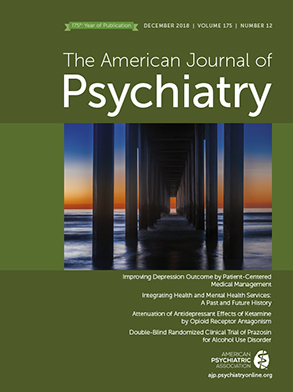Childbirth is a powerful trigger for psychiatric illnesses that carry considerable morbidity and mortality (
1). Perinatal suicide is a leading cause of maternal death (
2). Many women discontinue treatments that have previously been effective for them when they become pregnant (
3). Untreated psychotic pregnant or postpartum women may experience command hallucinations, delusions involving the baby, suicidal ideation, and aggression (
1). Rapid mood swings, bizarre behaviors, disorganized thinking, impulsivity, and impaired judgment place mother and fetus in danger. Furthermore, disordered thinking focused on the fetus may precipitate fetal abuse or feticide. Psychotic denial of pregnancy, although rare, occurs in some women who experience psychotic symptoms (
4). Denial poses a risk that the mother may engage in dangerous behaviors or neglect to identify labor, placing herself and the fetus at risk.
Adverse obstetric and neonatal outcomes among women with psychosis at the time of delivery include heightened risk for cesarean delivery, antepartum and postpartum hemorrhage, placental abruption, poor fetal growth and prematurity, stillbirth, fetal abnormalities, and fetal distress (
5).
Untreated psychosis during pregnancy is also a strong predictor of postpartum psychosis, which is associated with elevated rates of suicide and infanticide. The annual Confidential Inquiry Into Maternal Deaths in the United Kingdom identifies suicide as the most common cause of maternal death in the first postpartum year (cited in reference
2). Methods of suicide tend to be violent, such as hanging or jumping, and only 3% died from an overdose of medication (
2).
Infanticide, a rare outcome of postpartum psychosis, is a tragedy with an innocent victim, but the perpetrator is often a victim too (
6). In my 20-year experience, I have found that most infanticides are committed by unmedicated mothers. Because perinatal psychosis lacks diagnostic validity in DSM-5, its credibility is diminished in U.S. criminal courts. Unlike in most other Western countries, where these women receive psychiatric treatment, mentally ill women in the United States who commit infanticide may receive long prison sentences or even the death penalty.
There is a dearth of research to guide the management of pregnant women with severe mental illnesses such as affective psychosis, psychotic and nonpsychotic forms of bipolar disorder, and schizophrenia. Prospective controlled clinical treatment trials do not include pregnant women because of ethical concerns. Retrospective data have significant limitations and unclear outcomes. Many peer-reviewed reports fail to consider confounding variables, and they then incorrectly report birth defects ostensibly linked to the psychotropic medications. Often these studies are publicized in the media, and as a result, many women refuse medications necessary to control their illness when they become pregnant.
In this issue, a study by Cohen and colleagues (
7), using data from the Massachusetts General Hospital National Pregnancy Registry for Atypical Antipsychotics (NPRAA), sets a high standard for peer-reviewed journals to accept research data based on rigorous methodology. The researchers prospectively gathered data on the safety of quetiapine to determine the relative risk of major malformations in a cohort exposed during the first trimester compared with a nonexposed control group of pregnant women.
From November 2008 through March 2017, a total of 888 women between the ages of 18 and 45 enrolled in the registry. Outcome data on 357 women were available for inclusion in the analysis. Outcomes of 152 women who used quetiapine were compared with outcomes of 205 women with a history of psychiatric morbidity and no exposure to quetiapine or other atypical antipsychotics. Women who were exposed were more likely to have a diagnosis of bipolar disorder and to be using antiepileptics and antianxiety medications. Unexposed women were more likely to have a primary diagnosis of depression or anxiety and to be using selective serotonin reuptake inhibitors.
As assessed by a dysmorphologist blind to the mother’s treatment, infants of the mothers exposed to quetiapine had two confirmed major malformations (1.3%), compared with three major malformations (1.4%) in the nonexposed group. These findings, interpreted in the context of the existing 3% baseline rate of birth defects in the population (
8), are reassuring. The unadjusted odds ratio for major malformations comparing infants exposed to quetiapine to unexposed infants was 0.90 (95% CI=0.15, 5.46), which, reassuringly, matches the pooled estimate of all available data on fetal exposure to quetiapine (pooled risk ratio=1.03, 95% CI=0.89, 1.19).
Among the significant strengths of the NPRAA data is that they include documentation of the mother’s psychiatric illness and associated features, such as smoking and drug and alcohol use. Vital information on other illnesses and use of prescribed and over-the-counter drugs was also confirmed. The methodology provides assurance for the clinician that outcome data are valid and that confounding variables have not distorted results.
Quetiapine is the only antipsychotic medication studied in pregnancy with such a rigorous methodology. Although quetiapine is commonly used for multiple disorders, including for major depression and as adjunctive therapy to antidepressants, its true value in the perinatal period is its efficacy in serious mental illness with psychosis. The Cohen et al. study is reassuring for pregnant women with schizophrenia for whom quetiapine is effective. The data on quetiapine also benefit pregnant women with bipolar disorder, for whom options for mood-stabilizing agents are limited because of the risk of congenital anomalies with antiepileptic agents and lithium. Although lamotrigine seems to be the most benign mood stabilizer, quetiapine may provide mood-stabilizing and antipsychotic effects and limit fetal exposure to one agent.
The work of Cohen et al. and the new product labeling from the U.S. Food and Drug Administration governing the latest Pregnancy and Lactation Labeling Rule indicate a major shift in reporting on birth defects (
9). This change from the misleading and haphazard letter labeling (A, B, C, D, and X) to descriptive summaries and documentation of findings provides the psychiatrist and the patient with appropriate information to make an informed decision. For too long, women, their physicians, and the public have been misinformed by inadequate data and misleading reports.

